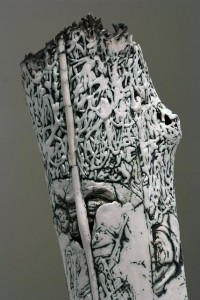
In my current work I am investigating the concept of devastated trees, damaged through natural phenomena such as floods, hurricanes, tornadoes, or age, and also trees destroyed through human intervention. I have been collecting the remains of trees that have been broken, eroded, stripped of their bark, and cut. In my studio, these fragments have become metaphors for the inevitable process of decay and loss that occurs over time. Using porcelain, I am attempting to rebuild the trees by making casts of the demolished remnants. In my reclaimed ceramic trees, organic motifs and text are embedded in the trunks or applied to the surfaces of the segments that are being pieced together in a symbolic attempt to help mend the ravaged trees. The reconfigured ceramic forms embody traces of the trees’ history and stand as memorials to loss. At the same time, in my efforts to reconstruct them in clay, and by creating a new textual “bark” for the trees, I also acknowledge the potential for regeneration and recovery. The words devastated and remembered, and their Latin counterparts devastatus and rememorari are inscribed over and over again, imprinting a “texture of memory”1 on the porcelain trees.
When I arrived in Halifax in 2006, I was profoundly moved by my first visit to Point Pleasant Park, and still, after numerous subsequent trips to the park, my awe at the magnitude of what took place there in September 2003 has not diminished. Point Pleasant Park provides stunning evidence of nature’s potential for destruction and its inherent power to heal itself. In my exhibition at the Mary E. Black Gallery, I pay tribute to this cherished urban retreat.
- James E. Young, The Texture of Memory: Holocaust Memorials and Meaning (New Haven and London: Yale University Press, 1993), Preface, p. ix. ↩